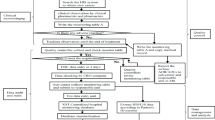Summary
Qingkailing (QKL) is a modern preparation exploited according to the traditional Chinese medicine theory. It becomes the second leading cause of adverse drug events (ADEs) in all traditional Chinese medicine injections. The safety evaluation and rational use of QKL are of special importance. This retrospective study used data from Adverse Drug Reaction Monitoring Center of Hubei Province in China from January 2012 to December 2014. ADE cases induced by QKL were collected and analyzed according to patients’ demographics, characteristics of drugs involved, characteristics of ADEs, causality, and outcomes. A total of 1330 qualified ADEs were included. Most ADEs occurred within 30 min after administration and the 0–10 years old age group had the highest number of ADEs. The common ADEs included anaphylactic reaction, dyspnea and nausea. Serious reactions accounted for 5.19%. Combination with cephalosporin (74/146, 50.69%) caused more ADEs than other drugs did. Serious attention should be paid when QKL is used for children, and combination with cephalosporin should be avoided.
Similar content being viewed by others
References
World Health Organization. (2013}). WHO traditional medicine strategy: 2014-2023}. World Health Organization}. https://doi.org/www.who.int/iris/handle/10665/92
Chan K, Zhang H, Lin ZX. An overview on adverse drug reactions to traditional Chinese medicines. Br J Clin Pharmacol, 2015,80(4):834–843
Zhang J, Wang S, Xu L, et al. Multiple perspectives of qingkailing injection-fraction-single compound in revealing the hepatotoxicity of baicalin and hyodeoxycholic acid. J Ethnopharmacol, 2018,215:147–155
Ji K, Chen J, Li M, et al. Comments on serious anaphylaxis caused by nine Chinese herbal injections used to treat common colds and upper respiratory tract infections. Regul Toxicol Pharmacol, 2009,55(2):134–138
Strengthening Pharmaceutical Systems (SPS) Program. Indicator-Based Pharmacovigilance Assessment Tool: Manual for Conducting Assessments in Developing Countries. Arlington, VA: Management Sciences for Health, 2009. https://doi.org/pdf.usaid.gov/pdf_docs/PNADS167.pdf
Nebeker JR, Barach P, Samore MH. Clarifying adverse drug events: a clinician’s guide to terminology, documentation, and reporting. Ann Intern Med, 2004,140(10):795–801
Provisions for Adverse Drug Reaction Reporting and Monitoring (Order No.81 of the Ministry of Health) https://doi.org/www.moh.gov.cn/mohzcfgs/pgz/201105/51770.shtml
Miao X, Zhou J, Li J, et al. Chinese Medicine in Inhalation Therapy: A Review of Clinical Application and Formulation Development. Curr Pharm Des, 2015,21(27):3917–3931
Yang Y, Wang SC, Bai WJ, et al. Evaluation by survival analysis on effect of traditional Chinese medicine in treating children with respiratory syncytial viral pneumonia of phlegm-heat blocking Fei syndrome. Chin J Integr Med, 2009,15(2):95–100
Wang Z, Wang D, Sui Y, et al. Experimental study on anaphylaxis of qingkailing injection and its components on Beagle dogs. J Tradit Chin Med, 2012,32(4):641–645
Li H, Deng J, Yue Z, et al. Detecting drug-herbal interaction using a spontaneous reporting system database: an example with benzylpenicillin and qingkailing injection. Eur J Clin Pharmacol, 2015,71(9):1139–1145
Gao P, Zhang CL, Zeng FD, et al. Pharmacovigilance in China: issues of concern identified through an analysis of the Chinese Adverse Drug Reaction Information Bulletin 2001 to 2014. J Clin Pharm Ther, 2015,40(5):594–598
The State Pharmacopoeia Commission of the P. R. China. Pharmacopoeia of the P. R. China (Chinese). Beijing: Chemical Industry Press, 2010:1110–1111.
Li, Q, Zhang, XY, Chen GK. Adverse effect and mechanism of chlorogenic acid in clearing heat and detoxication traditional Chinese medicine injections. Chin J Mod Appl Pharm (Chinese), 2009,26(7):555–558
Li BQ, Dong X, Yang GQ, et al. Role of chlorogenic acid in the toxicity induced by Chinese herbal injections. Drug Chem Toxicol, 2010,33(4):415–420
Zhang Z, Qin L, Peng L, et al. Pharmacokinetic-Pharmacodynamic Modeling to Study the Antipyretic Effect of Qingkailing Injection on Pyrexia Model Rats. Molecules, 2016,21(3):317
Guo M, Zhang L, Liu H, et al. A metabolomic strategy to screen the prototype components and metabolites of Qingkailing injection in rat urine by high-performance liquid chromatography with tandem mass spectrometry. J Sep Sci, 2014,37(20):2844–2850
Peng L, Gao X, Song Y, et al. A rapid and sensitive UPLCMS/MS method for quantification of two caffeoylquinic acids and four main active components in rat plasma after an intravenous administration of Qingkailing injection and its application to a pharmacokinetic study. Biomed Chromatogr, 2014,28(5):601–609
Zhang L, Wang X, Su J, et al. One single amino Acid for estimation the content of total free amino acids in qingkailing injection using high-performance liquid chromatography-diode array detection. J Anal Methods Chem, 2014,2014:951075
Acknowledgements
The authors acknowledge the important contribution of Hubei ADR Monitoring Center network participants in providing data.
Author information
Authors and Affiliations
Corresponding authors
Additional information
This work was supported by grants from the National Science Foundation for Young Scientists of China (No. 71503089), and the Fundamental Research Fund for the Central Universities (No. 2016YXMS146).
Rights and permissions
About this article
Cite this article
Wu, Bl., He, Wx., Ke, M. et al. A Retrospective Analysis on 1330 Adverse Event Reports of Qingkailing in China: Further Perception of Its Risks and Rational Use. CURR MED SCI 38, 1103–1108 (2018). https://doi.org/10.1007/s11596-018-1990-2
Received:
Revised:
Published:
Issue Date:
DOI: https://doi.org/10.1007/s11596-018-1990-2



